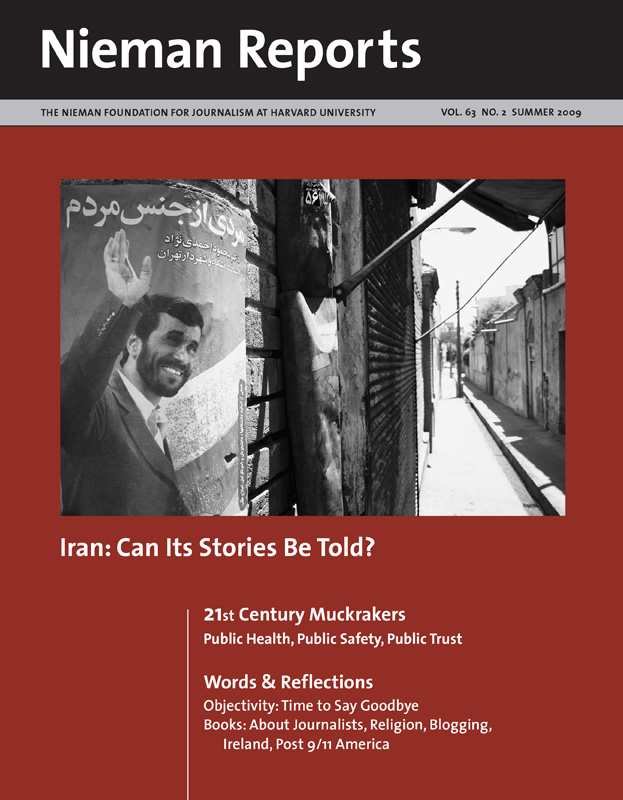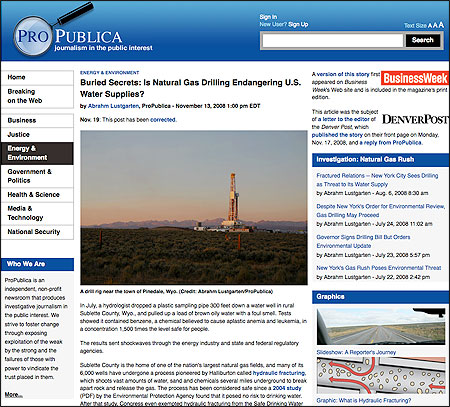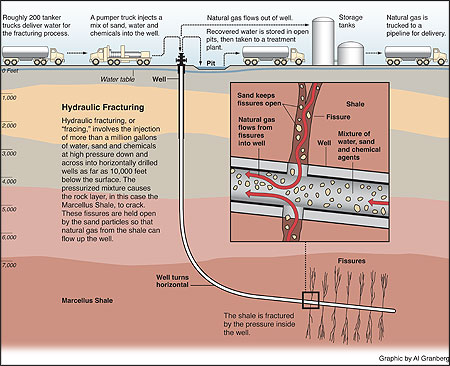
Iran: Can Its Stories Be Told?
Journalists — Iranians and Westerners — share their firsthand experiences as they write about the challenges they confront in gathering and distributing news and information about Iran and its people. Their words and images offer a rare blend of insights about journalists’ lives and work in Iran. In the fifth part of our 21st Century Muckrakers series about investigative and watchdog reporting, the focus turns to coverage of issues involving public health, safety and trust. And in Words & Reflections, essays touch on objectivity, religion, blogging, Ireland and post 9/11 America.

ProPublica displays Lustgarten’s story with links to news organizations that published his story. Other reporting he has done on this topic is also available.
I landed on the story of contaminated water from natural gas drilling because I had enjoyed flexibility rare in journalism today. In fact I had come to ProPublica, a start-up venture dedicated to investigative projects, precisely because I hoped to escape the story quotas and budget constraints that inevitably made my magazine reporting rushed and incomplete. In my new job, I was given time and support to investigate obscure leads and tenuous threads of interest until one critical issue emerged that could be spun into a project with currency and weight.
The project began with an investigation into chemical contamination in public drinking water supplies—a story originally focused on the agriculture industry in the Pacific Northwest. For months I dug into the banal science, learning how to read water quality analyses and understanding the nation’s laws and convoluted methods for determining when a particular “constituent” became a “contaminant”—both terms that carry extraordinarily specific semantic meaning in the world of science.
Along the way I got an education in federal drinking water standards. I met with municipal water managers, engineers from treatment plants, toxicologists and health officials. I became a voyeur into the precise world of environmental water science and found that its regulation, where almost every detail is explicitly laid out and considered, is intended to be equally exact. Very little seemed to be left to chance.
Then I stumbled on a water issue that appeared to be all about chance. I spoke with a hydrogeologist with the U.S. Geological Survey who was alarmed about a process being used by the energy industry in which a whole bunch of chemicals are pumped directly into the ground and could potentially reach water supplies. My source didn’t know much more—in fact he explained that this process, called hydraulic fracturing, was not regulated by the federal government and that the Environmental Protection Agency didn’t have the authority to examine it.
But there were new plans to drill for natural gas along the Eastern seaboard, including in New York City’s watershed, and this person described a quiet undercurrent of concern that he said extended throughout the scientific community. At this point all that background fodder I had collected had a purpose; without my newly acquired knowledge of water science, I would never have been able to understand the implications of the drilling issue or expand it into a full-fledged investigation.

A graphic display of hydraulic fracturing. Click on graphic to view in full size.
Digging Deeper
Hydraulic fracturing, I soon learned, involved shooting large amounts of water, sand and chemicals at high pressure down a freshly drilled well in order to crack the geologic deposits that hold natural gas thousands of feet below and release that gas so it can flow back out of the well. The extraordinary water pressure—thousands of pounds—literally fractures the rock. Then the sand floats into tiny cracks and holds them open while bubbles of gas escape to the surface. A proportionally small amount of chemicals are used to control the viscosity of the water, kill off bacteria, and otherwise optimize the whole operation, but considering that several millions of gallons of water might be pumped into a gas well, that can amount to tens of thousands of gallons of toxic substances put into the ground.
The process is nearly ubiquitous. Hydraulic fracturing is used in nine out of 10 gas wells drilled in the United States and is crucial to extracting hard-to-reach geologic deposits of gas at a time when energy independence is of paramount importance. Plus, natural gas is viewed as a “transitional fuel” even by environmentalists—it is cleaner burning than any other fossil fuel and emits 23 percent less carbon dioxide than oil. For these reasons, plus the discovery of new deposits like those in New York State, gas drilling activity is expanding faster than any other domestic resource or energy program.
At first, I saw a straightforward explanatory story. Here was a fascinating technological process that few people seemed to know about. The state governments dealing with it should be able to address predictable questions about how the chemicals are managed and treated, what the risks were, and how they were handling them.
But when I eventually sat down with environment and gas drilling officials for New York State, they were caught off guard by the plainest of questions. What chemicals would they be permitting to be pumped into the ground? What waste would be produced, and where would it be disposed of? And did the practice threaten the state’s water supplies?
They could not answer any of these questions. In fact, they weren’t even aware that chemicals were used in hydraulic fracturing. They had never asked and never been told exactly what was being pumped into the earth; they assumed that the primary byproduct of drilling was plain water. Thus they had no plans in place to dispose of the waste; by default it would be sprayed on roads and discharged through conventional sewage plants back into the area’s rivers.
EDITOR'S NOTE:
His story, “Buried Secrets: Is Natural Gas Drilling Endangering U.S. Water Supplies?” was published by ProPublica on November 13, 2008. The story was also published in BusinessWeek and on the front page of The Denver Post as part of ProPublica’s effort to disseminate its investigative stories widely.I wanted to drill deeper, but it would cost money and take more time. My editor, Steve Engelberg, said to go ahead. In fact, at each juncture in my reporting he continued to enthusiastically green light more time, more airplane tickets, more research.
As it turned out, the information I sought was clouded in secrecy. The identity of the chemicals used in the drilling was a closely guarded competitive secret, protected as proprietary trade recipes by the drilling contractors who used them. Neither the state agencies nor the EPA had a complete list of what was being used, and scientists were telling me that they could not measure any threat or decide if the process was safe, because they couldn’t trace the source of pollution without knowing the names of the chemicals used in fracturing.
Gas drilling activities were further shielded by exemptions from the Safe Drinking Water Act and the Clean Water Act—the two federal laws designed to maintain water quality and protect American’s drinking supplies, as well as make the law consistent across the country. Those exemptions removed any federal oversight and left environmental enforcement—and the robust task of funding and conducting scientific research—to individual states like New York. It meant that federal science agencies were not even tasked with examining the processes.
Employees of the oil and gas industry offered seemingly simple answers to the possibility that drilling posed a threat. The quantity of the chemicals they used is too small to have an impact, and it is diluted in vast amounts of water, they said. Those fluids can’t leak underground from one geologic layer to another because the layers of rock provide a watertight seal. Occasional accidents have been statistical anomalies. Because of these factors, it wasn’t necessary to divulge the exact recipes used in the fracturing fluids—the process was already proven safe. In fact, they repeated often, even though more than a million wells had been drilled, there had never been a single instance anywhere in the United States where hydraulic fracturing had been proven to result in contaminated water.
On the other hand there were shrill environmentalists who claimed the fluids were highly toxic and who painted a conspiratorial picture of a powerful industry that had lobbied the federal government to pass laws that would allow them to look the other way as a burgeoning gas drilling industry spread quickly across the United States.
I was tasked with finding my way through this minefield of statements and passionate opinions and discovering the truth, along the way striving to answer questions that sprung up far faster than they could be answered:
- If the fracturing process does not harm water, then why was a water-related exemption sought from the federal government?
- If chemicals could not move underground, then why wouldn’t the industry release the names—even confidentially—to scientists trying to test water and measure environmental change?
- What scientific research justified the oil and gas industry earning legal privileges that are not afforded to the mining, auto, coal or agriculture industries?
- Most importantly, was it true that hydraulic fracturing had never contaminated water?
These are the kinds of questions that take time, travel and funding to answer.
Science and Sources
First I began to review spill records, which are not kept in many of the 32 states that permit oil and gas drilling but are substantially documented in both New Mexico and Colorado. Then I poured through more scientific literature, including several EPA studies that addressed hydraulic fracturing and wastewater—finding critical warnings buried hundreds of pages deep in otherwise boring reports. Finally, I traveled to the quiet rural towns across the Rockies where drilling was happening most, talked with ranchers and landowners about their experiences with nearby drilling and heard unpublicized tales about when things had gone very wrong.
The assertion that fracturing had never harmed a water supply, I quickly came to understand, was based on a narrow interpretation that literally meant that the actual action of pumping fluids into the ground under pressure had not been proven to have directly resulted in an explosion or other accident that happened during that actual pumping process. It excluded everything else having to do with the fracturing process, including the mixing of chemicals, their transport, and their disposal.
But since this process brings a large quantity of chemicals to a site and creates substantial waste stream, I quickly found that if you look beyond the actual drill bits turning and pumping underground and include accidents happening on the surface, there was a sizeable impact.
In order to learn more, I focused on a handful of incidents—about a dozen to start with—in which the contamination was more than an allegation and had been thoroughly documented by state inspectors or been written about in a published official report of some kind. I spent several weeks sitting on porches or walking in fields listening to the stories of people whose wells had been poisoned, or whose animals had died or, in some cases, who had been hospitalized after drinking or breathing fluids from fracture fluid accidents.
In many cases I had the budget to take chances and to not take no for an answer. When a nurse involved in a chemical spill said on the phone that she wasn’t comfortable talking about her experience, I hopped on a flight to her hometown of Durango, Colorado anyway and knocked on her door. Meeting eye to eye instilled her with enough trust to share her story.
Trust was built similarly with sources at federal agencies, like the EPA, who are typically averse to handling controversial questions on the phone but tend to open up over lunch. That patience and personal engagement may explain how I eventually saw a memo on federal government letterhead that alleged widespread contamination of a drinking water aquifer in Wyoming that researchers feared might be the result of drilling activities like fracturing.
Throughout, my project treaded into the realm of uncertainty that often stops environmental and health reporting in its tracks. If you cannot prove that contamination made it from point A to point B, if there is not epidemiological evidence that a cluster of illness is firmly linked, for example, to exposure to a chemical, then you do not have an investigation, and you do not have a story—or so the rules often go. And those were exactly the scientific weaknesses that the industry, which fought regulators, politicians and anyone who investigated these issues at every step, sought to maintain.
But in this case I embraced the gray area between those stark lines and sought to raise questions that underlined the uncertainty of the situation. All of the information I gathered established a sketch of a problem, and it seemed to exist in almost every drilling area that we examined. I couldn’t prove fault—that would be the job of scientists and was the very opportunity that they were arguing for. I could establish that this process being used across the country, which had become an important link in an emerging national energy policy, did not appear to be as harmless as the industry and its regulators believed. At the least, it warranted further examination.
Abrahm Lustgarten is a reporter at ProPublica.